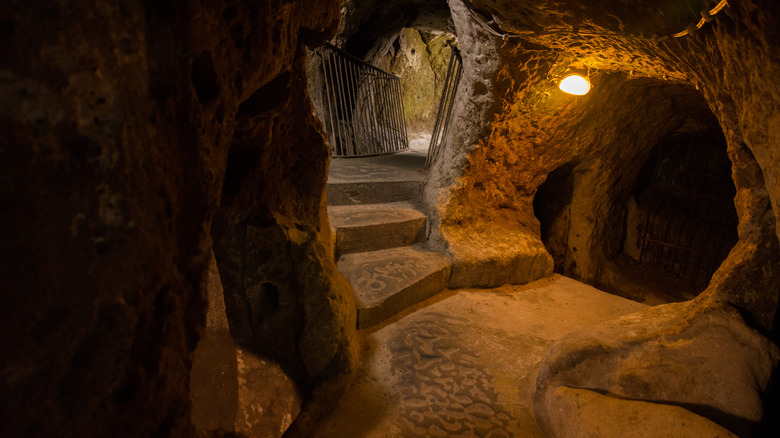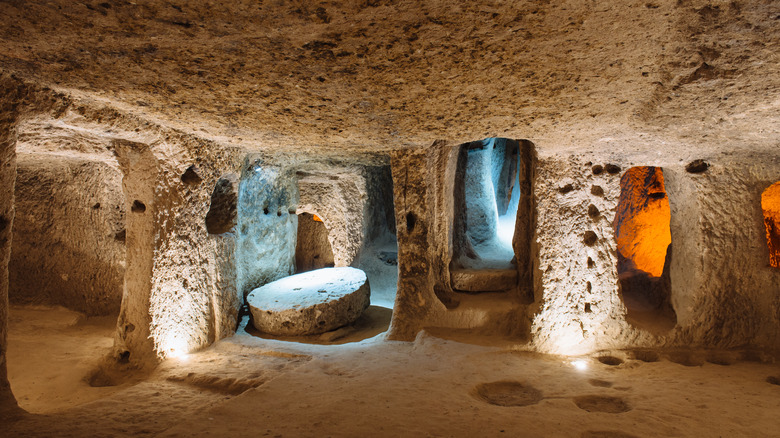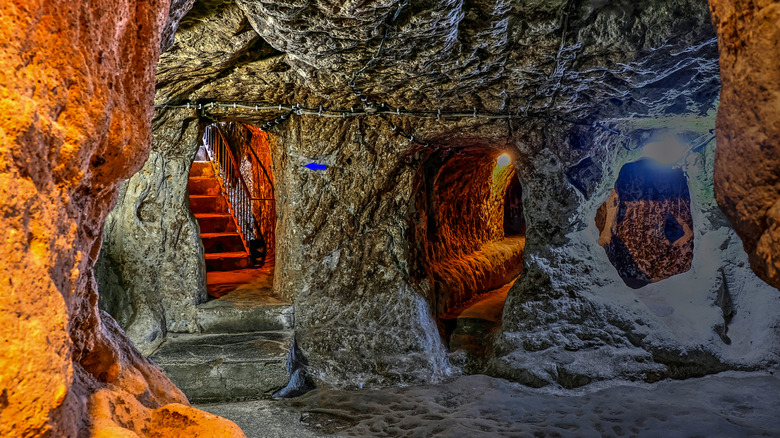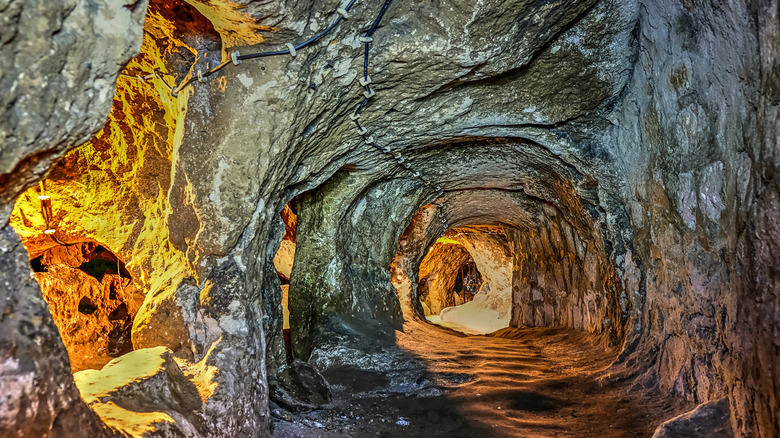The Truth About Derinkuyu, An Ancient Underground City
What's the most interesting thing you've ever found while spring cleaning? How about a secret underground city? That's just what one Turkish man uncovered when he discovered a room hidden behind a wall in his house –- a room that led to an intricate network of tunnels that would come to be known as the Derinkuyu Underground City (via Atlas Obscura).
Unearthed in Derinkuyu in central Turkey, the tunnel system is a complex and large system of rooms and passageways. In addition to standard pathways, the tunnel system has wells, ventilation shafts, and water sources (via Sometimes Interesting). The massive system reaches over 18 stories underground, or over 200 feet, and is carved from volcanic rock, according to ZME Science. Historians suggest that the tunnel system could have held a whopping 20,000 people at a time, and the complexity of its rooms suggests it was designed to host citizens for long periods, with designated rooms for churches, stables, and even wineries.
The history of the Derinkuyu underground city
Some historians estimate that construction on the Derinkuyu underground city began between the 8th to 7th centuries BCE, while others say the compounds weren't built until hundreds of years later, according to ZME Science. However, it is clear that the tunnels are thousands of years old. Though carving a huge city from rock may seem like a massive physical undertaking, the rock around Derinkuyu is made of volcanic rock, which is softer than traditional stone and easier to carve (via Sometimes Interesting). As a result, it's thought that citizens likely contributed to the initial building of the city, carving out little caves and rooms for themselves which were later expanded.
Initially, these rooms might have been used as a breezeway or ice shed, where the naturally controlled temperature kept food items protected from the elements. However, over time, as the underground tunnel system was built up into a city, its purpose changed and became more defensive. If Derinkuyu was ever invaded, the tunnels provided a great place for citizens to flee. Not only were they difficult to find -– evidenced by the hundreds of years they went unnoticed before a random citizen stumbled upon them — they also had plenty of in-built defensive measures, including massive stones which could seal off passages and stone doors as much as two feet thick (via Atlas Obscura).
How Derinkuyu changed over time
While it's difficult to definitively trace the growth of the Derinkuyu underground city over time, there are some writings that can potentially be tied to Derinkuyu, according to ZME Science. Some historians attribute the initial build of the tunnels to the Phrygians, while others have suggested the Persians or Hittites might have been the creators of the system.
One early written account of the tunnels was by Xenophon of Athens and was dated to 370 BCE. It potentially describes the Derinkuyu city, elaborating on how many Anatolian citizens had excavated large caves underneath their houses.
Later, the networks of the caves were expanded to include chapels when Christianity expanded into Turkey, according to My Modern Met. Even later, from around 780 to 1180, the city was modified to accommodate an influx of Muslim Arab inhabitants, who fled to the tunnels during the Arab-Byzantine wars. At its apex, the complex covered as much as 172 square miles of space.
What life was like in the Derinkuyu city
Life within the Derinkuyu cave system was surprisingly advanced, according to ZME Science. Though you might imagine it's hard to carve complex rooms out of rock, the Derinkuyu city had a wide variety of types of rooms as well as other advanced features. Most family homes dug out of the rock had multiple rooms, including bedrooms, bathrooms, and kitchens. And as a bonus, homes carved out of rock tended to maintain cooler temperatures during the summer than standard homes, meaning there was a real benefit to living in these cave homes.
In addition, the complex had various other types of public meeting spaces, including markets, schools, and areas of worship. The hallways were lit with torches, and there were sophisticated doors and escape hatches that made the city one of the safest places to be during a potential invasion. Overall, this meant that, over the years, the cave system was used multiple times by different groups seeking to avoid persecution. And recent evidence has suggested that other similar cave systems might be carved into the rock of other Turkish cities, meaning the idea was clearly popular.



